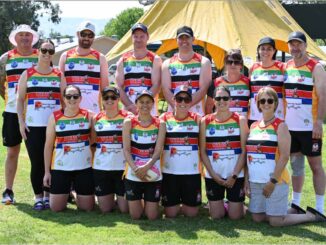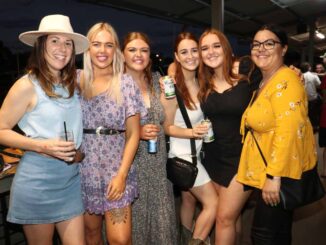
Catholic Section at the Cobar cemetery.
According to local legend, Kate McKenzie was a very eccentric woman who used to walk the streets of Cobar wielding a stock whip which she threatened to use to keep kids in line.
And while many Cobar residents may have indeed feared her, there’s no doubt Kate McKenzie goes down in history as a ‘Cobar icon’.
When Kate died in 1964, she had no family to speak of and was buried at the Cobar Cemetery in the old Catholic Section in a nondescript grave.
A group of concerned residents, headed up by Jill Weaving, rallied around and raised funds to give Kate a proper grave.
“The money was raised by the townspeople and a few people volunteered to do the work,” Jill said.
“Wayne [her husband], Neville Good, Rusty [Kevin] Mitchell and Tim Arnold have all helped and the Buffalo Lodge gave us $500.
“All up we raised $2,271.05.
“We purchased two headstones, one for Kate and another for John Kowalski, Johnny the Balt.
“It was $2,000 for the two headstones and we just made up the rest of the costs for concreting etc ourselves,” Jill explained.
She said as Johnny the Balt (who Jill describes as another Cobar icon) wasn’t buried in Cobar, it’s still to be sorted where his headstone might be located.
Jill said she’s been talking with Cobar Shire Council staff about locating the plaque at the old Council Chambers building in Linsley Street (the now Family Day Care offices) as that’s where one of Johnny the Balt’s mural paintings is located.
Jill also hopes Kate and Johnny will be included in council’s plans for a visitors tour of Cobar characters.
The Great Cobar Museum curator Kay Stingemore welcomed the help Jill and her team have given to restoring Kate’s grave at the cemetery.
“It’s extremely important to note that council staff care about and work very hard to maintain the cemetery,” Kay said.
“Our cemetery holds so much of our history. Sadly, time takes away some of the stories – many graves have no marker and on others, the markers are either partly or totally disintegrated.
“This is not because people didn’t or don’t care – it’s often because remaining family couldn’t afford a marker, or they left Cobar and have been unable to maintain the graves.”
Kay said they are currently working on a project to capture and retain as much family and community history as possible.
“A sign of the significance of this is the very high number of enquiries we get from both locals and visitors wanting to visit the cemetery and locate particular graves.
“Whenever cemetery tours are held, many people attend because they want to know the history and stories and understand how people and places are connected,” Kay said.
“The stories in the cemetery tell of individual people and their families, but there is also a great deal of wider significance, such as the deaths that tell us about pandemics of influenza, repeated epidemics of typhoid and other diseases, or the names that tell us that people came from all over the world to Cobar.”
Kay said they hope to find out how many languages there are on headstones in Cobar cemetery and wonders how many more were spoken by those who don’t have headstones.


